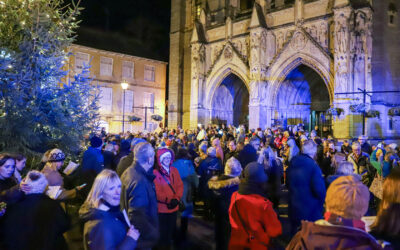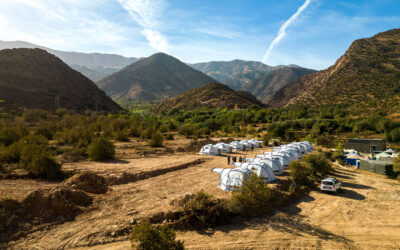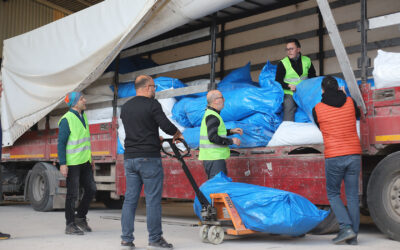Aftershocks were still sending people fleeing into the streets when the storm warnings went out. A powerful tropical storm was building, preparing to lash the areas worst affected by the earthquake.
Search and rescue teams fought to find survivors in the rubble before the weather closed in.
‘People faced an impossible choice: stay outside, exposed to the elements, or seek shelter in damaged, dangerous homes,’ says Alice Jefferson, who leads responses at ShelterBox.
For two days, at least 25cm of rain hammered the southwest of Haiti, followed by flash floods and mudslides.
Challenges to overcome
The combined force of the earthquake and storm destroyed an estimated 61,000 homes and damaged 77,000 more. People like Vanose, 68, lost everything and had to shelter under trees.
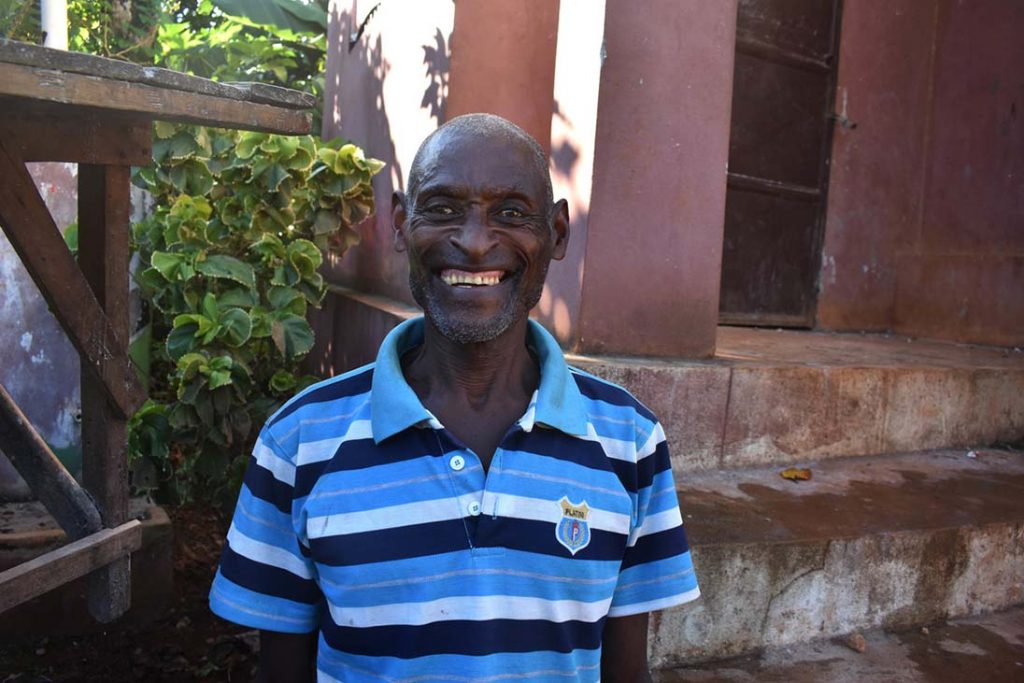

This is 68 year old Vanose, his house collapsed during the earthquake that struck Haiti in August. He currently sleeps under a tree where he has constructed a makeshift shelter for himself. © Habitat for Humanity International
Reaching remote communities became even more difficult – roads had been washed away, or split and scarred by the quake.
We knew that a response in Haiti would be challenging. The country is still recovering from 2010’s catastrophic earthquake, as well as Hurricane Matthew in 2016. A quarter of Haiti’s population live in extreme poverty, and the President’s assassination in July made an already fragile security situation more volatile.
‘Choosing to sleep outside’
We’d worked in similar rural areas near Les Cayes following Hurricane Matthew. We’d learned that communities were keen to leave group shelters and rebuild, but often lacked the materials because of the remoteness of the area – and underlying poverty.
We were preparing to send our first response team – including volunteers – since the coronavirus pandemic severely limited international travel. But a local partnership was still essential to hear communities’ needs and reach vulnerable families.
Members of local Rotary clubs had been directly affected by the disaster themselves, and their spare capacity was understandably limited as they ran their own relief efforts in their communities. We did remain in direct communication with senior Rotarians both within Haiti and in the wider region, sharing information is incredibly important.
Following months of joint planning for a potential disaster in the Caribbean, we could partner swiftly with Habitat for Humanity Haiti. They’ve been working in the country since 1984.
‘Quality shelter materials were in scarce supply,’ remembers Jean Frenel Tham, National Director of Habitat Haiti. ‘Even families whose homes were still standing were choosing to sleep outside for fear their damaged homes could still cave in.’
Aid gets on the move
As soon as news of the earthquake hit, plans had taken shape to move aid from ShelterBox’s nearest warehouse in Panama.
Getting that aid into Haiti would be difficult. Shipping times were long and hampered by a global shortage of shipping containers, as well as security risks at Haiti’s ports. So we worked closely with Airlink to charter two flights to rush 71 tons of cargo to Haiti, including tarpaulins and fixings, thermal blankets, solar lights, kitchen sets, sleeping mats, mosquito nets and water carriers.
Despite the security challenges – on top of the usual post-disaster delays caused by blocked roads and busy ports – the partnerships forged and regional plans already in place meant we could deliver aid swiftly to Haiti. It takes time to get the right aid to the overlooked, often remote communities that ShelterBox prioritises. It’s testament to everyone’s teamwork that practical, useful, requested aid was in the right hands within weeks – and will set families up with a first step to longer-term solutions.
We chose shelter kits rather than tents, to help families stay on their home sites. This avoids the unplanned ‘tent cities’ that carry higher risks of poor sanitation, crime and exploitation.
We also included a cash payment for families to buy materials, or hire a labourer to clear rubble and help with construction. And it could cushion them financially from selling their aid items just to be able to eat.
‘In the wake of a disaster, needs are sharp and choices are tough. Some survivors don’t have the luxury of thinking beyond the next meal,’ explains Dave Ray, ShelterBox Horizons Lead who responded in Haiti. ‘Cash support was carefully planned to make sure people had emergency shelter, without it being eroded by other priorities.’
People power
ShelterBox has been working hard to respond through our trusted, dedicated partners since early 2020. But it’s clear that in-person responses will remain at our heart.
‘When you’re working in-country, that response gets all your focus. Local conversations happen more quickly, without the hurdles of time zones and waiting for emails,’ Dave adds.
Liberated from wobbly video connections, teams could share skills in person, such as how to strap down materials securely and strengthen shelters with bracing techniques.
Within weeks of the earthquake, families were beginning to rebuild with the materials, equipment and information they needed. After Adeline’s house collapsed in the earthquake, she lived in a shelter made of tree leaves.
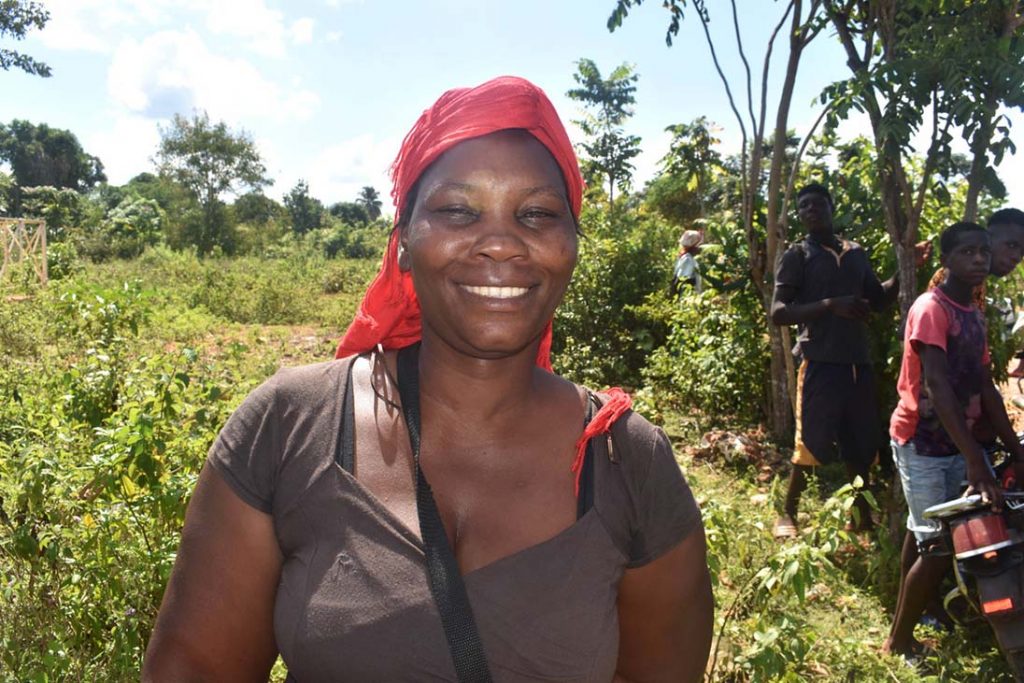

Adeline is from Valce where her house collapsed. She sleeps under a makeshift shelter made of tree leaves. She is an unemployed mother of six children, 2 girls and 4 boys, who all live with her. © Habitat for Humanity International
‘The tarpaulin that comes with this kit will be a life saver for us. We’ve not been able to get back on our feet after the earthquake, so it’s nice to receive some help when it comes.’
That’s thanks to supporters like you, who give generously throughout the year.
We don’t know what the next disaster will be, but with your support we know we will be ready. If your Rotary club want to ensure we can restock fast, why not take on The Warehouse Challenge? Find out more and sign up here https://www.shelterbox.org/warehouse-challenge-blog-cta/








